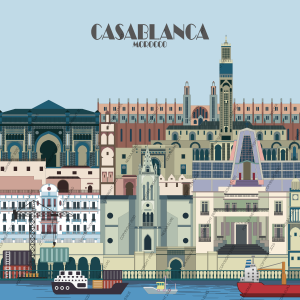Casablanca, the biggest city in Morocco, is referred to as the Atlantic Ocean business powerhouse. It is most notable for the amazing variety of architectural design on display in the city. The large boulevards, which constitute French colonial inheritance of the area, include Mauresque architecture, an aggregate of Moorish and European Art Deco. The architecture and the urban planning in Casablanca developed in a way that was both unique to the context of the region and compatible with foreign ideas. In the early twentieth century, the French architect Henri Prost was commissioned to rebuild the city as the new region’s financial hub and to be the representative city of French colonies. Epitomizing a rich and unique inheritance of Moorish architecture, combined with a French-colonial style, his large boulevards and current urban planning still survive nowadays. The city’s urban skyline provides a myriad of architectural styles.
Many genuine examples of traditional Moroccan architecture are preserved in Casablanca, in particular inside the city walls of the historic Medina. From this Medina and the first basin of the port, Casablanca grew. Regarded as the historic city center, it is surrounded by the ancient city wall having eight entrance doors, the most well-known is the Marrakech gate on the south side of the ancient town. Close to that gate, the city’s clock tower is located just in front of the Bab es Souk Door. The square-shaped tower mimics the traditional minaret style. La Sqala’s café, overlooking the entrance to the harbor, was originally a fortified Portuguese corner in the wall. Just outside the city walls lies the Mosquée Ould el-Hamra, a minimalistic rectangular mosque. Located in a dense residential district, the mosque provides a humble feeling with its low-rise height and its simple white-washed Moroccan minaret.

To the East of the old Medina, the art Deco district is located, representative of the previous French colonial era of the city. It holds numerous iconic buildings that provide a unique image to the city: the executive square, the Arab League Park, the widespread boulevards planted with palm trees.
Casablanca is known for its diverse architectural styles. The traditional Moroccan style is well denoted by the stunning Hassan II Mosque. Erected in the 1990s to commemorate the country’s former king’s 60th birthday. Among the world’s largest mosques, the photogenic building is located alongside the coast. Built using the finest materials, it showcases Moroccan artisanship. It took more than seven years and 10,000 craftsmen to finish this impressive building. It represents one of the most famous sights of the city, with its grandeur and complexity. Several architectural details could be distinguished such as the impressive columns, horseshoe arches, tilework, carvings, enormous dome, and the ornate muqarnas (vaulting) on the ceilings.

Another famous depiction of the traditional Moroccan style, is the Royal Palace of Casablanca, the King’s official city home. Found within the delightful Habous Quarter. A fantastic complex where one can appreciate the external gate and walls. The lavish gate gives a sight of the greatness that lies past the entrance. The entrance gate of the royal residence is colorful, rich, and showing fine subtle elements. Lastly, the Moorish architecture is best represented by Mahkama du Pacha town hall, located inside the Habous zone. It is one of the diverse terrific structures that encircle the famous Palace Mohammed V square. The sophisticated government building has especially remarkable interiors, featuring a carved cedar wood ceiling, white marble columns, and exquisite colorful tile mosaics.
Moving on to another style, Sacre Coeur Cathedral was designed by French architect Paul Tournon in Neo-Gothic style, it adds to Morocco’s architecture which is as rich in beauty as in history. Even though it is called a cathedral, this particular all-white structure was never really the seat of a cleric. Erected at some point in the Nineteen Thirties, it was used as a Christian area of worship up until the Fifties. Nowadays, it is relinquished and neglected. The arched main entrance is flanked by two towers, topped with domed bell chambers, creating an imposing and memorable sight.
One bizarre structure of this city is the Al-Quds Mosque, previously Église de Sainte Marguerite. This building was built originally as a church during the colonial era, also following a Neo-Gothic style. After the country took its independence, the religious function of the building transformed into a mosque.

Another jewel left by the French era is Notre-Dame de Lourdes Church, a modernist Catholic church constructed in the Fifties by architect Achille Dangleterre. It is an elongated concrete form, with a high roof, white-washed façades, and an unusually shaped main entrance. it provides a great illustration of the European modernist architecture of that time. The colorful stained glass with its striking contrast to the pale walls constitutes the main attraction element of the church. It features the glasswork of the worldwide-famous stained-glass artist Gabriel Loire.
Besides the religious icons, the Villa des Arts is another illustration of the residential French style. It is located in a stylish Art Deco mansion from the Nineteen Thirties. The appealing art deco building holds a variety of modern artworks, by local and international artists.
In brief, Casablanca’s architectural heritage is an endless wealth for the country and the rest of the world. Numerous buildings are registered on the UNESCO WH list. According to UNESCO, Casablanca was an experimental architectural laboratory of the 20th century. Moreover, Morocco is one of the first nations to have followed the art deco style in architecture, drawing travelers, tourists, architects, planners, and designers from all around the world to commemorate its heritage.







